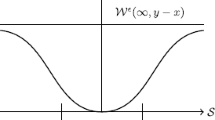Abstract
A method to analyze the evolution of a cohesive crack, particularly appropriate for asymptotic analysis, is presented. Detailed descriptions of the zeroth order and first order asymptotic approaches are given and from these results the far field equivalent elastic crack theorem is derived. An analytically soluble example, the Griffith crack, and a simple model, the Dugdale model, are used to exemplify the results.
Similar content being viewed by others
References
G.J.Barenblatt, Advances in Applied Mechanics 7 (1962) 55–125.
D.S.Dugdale, Journal of Mechanics and Physics of Solids 8 (1960) 100–104.
M. Elices and J. Planas, in Fracture Mechanics of Concrete Structures, L. Elfgren (ed.), Chapman and Hall (1989) 16–66.
J.N. Goodier, in Fracture, Vol. 2, H. Liebowitz (ed.), Academic Press (1968) 1–66.
A. Hillerborg, M. Modeer and P.E. Petersson, Cement and Concrete Research (1976) 773–782.
M.F. Kanninen, A.K. Mukherjee, A.R. Rosenfield and G.T. Hahn, in Mechanical Behaviour of Materials under Dynamic Loads, Springer-Verlag (1968) 96–133.
A.S. Kobayashi, in Computational Methods in the Mechanics of Fracture, S.N. Atluri (ed.), North Holland (1986) 21–51.
S.G.Mikhlin, Integral Equations, Pergamon Press, Oxford (1964) 21–51.
J. Rice, in Fracture, Vol. 2, Academic Press (1968) 192–311.
Author information
Authors and Affiliations
Rights and permissions
About this article
Cite this article
Planas, J., Elices, M. Asymptotic analysis of a cohesive crack: 1. Theoretical background. Int J Fract 55, 153–177 (1992). https://doi.org/10.1007/BF00017275
Received:
Accepted:
Issue Date:
DOI: https://doi.org/10.1007/BF00017275




